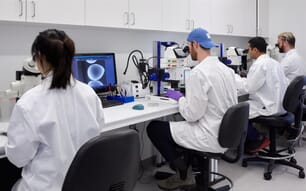Shrimp is a popular seafood item across the world. To keep up with high demand, farmed shrimp are bred in captivity before being stocked and reared in ponds. Because young shrimp would be gathered from the natural environment such as creeks or estuaries, breeding in captivity has become all the more important for shrimp farming, and helps reduce pressure on wild stocks.
However, the shrimp farming industry has often been criticized for its eyestalk ablation process. As well as detecting movement, a shrimp's eyes have specialized glands that produce hormones that control reproduction.
Removing, or the ablation of, one of a shrimp's eyestalks reduces the levels of a hormone that prevents reproduction, allowing shrimp to mature faster and release more eggs, as well as making egg production more predictable and efficient. Although some shrimp species are able to mature in captivity, egg production can be unpredictable, which is why ablation has been established as a standard practice in shrimp hatcheries worldwide.
Eyestalks can be removed through a range of techniques, such as pinching (pinching one eyestalk between the thumb and index finger and squeezing), cauterising (using a heated pair of forceps at the base of the eyestalk), or litigation (tying a thread or wire around the eyestalk and tightening the thread to limit blood supply, after which the eyestalk will fall off after a couple of days). Other less-invasive techniques have also been used, such as limiting the amount of light that the breeding animals are exposed to.
Concerns over eyestalk ablation are on the rise. For one thing, shrimp have a very simple nervous system and whether they feel pain is still not known. Other research has shown that the procedure jeopardizes growth, shortens the molting cycle, increases energetic demands and results in high mortality and an eventual loss of egg quality. But despite calls for an end to ablation, there are also concerns that if this happened, hatcheries would have to rely on natural breeding, which is slow, unpredictable and could lead to shortages of shrimp required to stock ponds, thus impacting areas such as communities in developing countries whose livelihood depends on shrimp farming. The demand for wild shrimp that already have eggs could rise further and have a major impact on wild shrimp populations.
However, a joint collaboration between Lyons Seafood, Seajoy, GAA and the University of Stirling has found that shrimp aquaculture could still be successful without the removal of eyestalks. The work began in 2014 due to client demand and future organic certification rules. Seajoy started by converting all of its larvae production laboratories to using only non eyestalk-ablated female shrimp.
Other tasks involved experimenting with feed, male-female ratios, and pre-maturation at the farm level with advanced selection and feeding. Male-female ratios were also adjusted during trials and the company increased the number of broodstock females to compensate.
"Right now it's about animal welfare," said Bradford Price, VP of operations and sales at Seajoy. "We can make a difference. To begin with, we set aside a few tanks to play with, to get a feel of how far we were away from commercial viability."
Today, 100 per cent of the company's shrimp produced in Honduras and Nicaragua are ablation-free and some have reached the market. Price also believes that non-ablated shrimp could one day become a requirement for producers that want organic and future certifications.
"We're producing a better animal," Price explained. "We did not expect things to be as easy as they were. The non-ablated shrimp also look so healthy it's astounding."
The next step for Seajoy, Lyons Seafood, GAA and the University of Stirling is to come up with a project to validate all the benefits of going ablation-free. At first, trials over the past few years only showed a few, but hopes are high. A doctoral candidate from Stirling is also researching this particular area.
"It's a great idea to have a candidate come in and validate what we're doing," said Price. "When he finishes, he's going to have some powerful data that says we need to look at non-ablated animals. As producers tend to focus entirely on production, animal welfare often gets lost in the midst of that. But thanks to our research that's no longer the case. Welfare is a larger issue."
Seajoy is continuing to test new and better ways of growing its shrimp sustainably, and is upgrading production to provide customers with further improved products in line with its philosophy of sustainable shrimp practices, including animal welfare.





